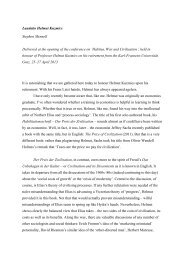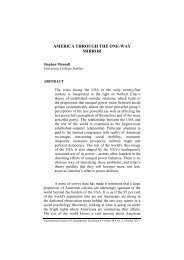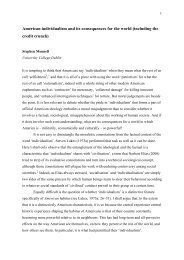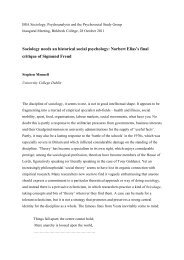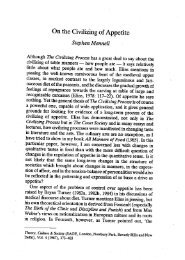Goudsblom behind the one-way mirror - Stephen Mennell
Goudsblom behind the one-way mirror - Stephen Mennell
Goudsblom behind the one-way mirror - Stephen Mennell
You also want an ePaper? Increase the reach of your titles
YUMPU automatically turns print PDFs into web optimized ePapers that Google loves.
5Despite his now much wider international reputation, <strong>Goudsblom</strong>’s bad luck inpublishing in English has continued. With <strong>one</strong> of his later books, I was myself directlyassociated. In Exeter sometime in <strong>the</strong> late 1980s, I had introduced Joop <strong>Goudsblom</strong> to EricJ<strong>one</strong>s, <strong>the</strong> Australian-based economic historian – more exactly, a self-proclaimed‘environmental historian’ – whose work he already admired. That led in turn to my arrangingfor <strong>Goudsblom</strong> to be appointed Visiting Professor of Sociology at <strong>the</strong> University of Exeter inMichaelmas Term 1988, coinciding with <strong>one</strong> of Eric’s frequent visits <strong>the</strong>re. Toge<strong>the</strong>r <strong>the</strong>three of us ran a seminar on very long-term development, and we <strong>the</strong>n assembled our papersinto <strong>the</strong> jointly-authored book Human History and Social Processes. 9 The title was perhapsunhelpfully vague. The book was published by University of Exeter Press at <strong>the</strong> very end of1989, less than two months before I left Exeter to take up a chair – partly at Eric’s instigation– in Australia. Since my wife Barbara had been <strong>the</strong> publisher at University of Exeter Press,<strong>the</strong> book was in effect ‘orphaned’. There was an interregnum following her departure, andvery little effort was made to sell <strong>the</strong> book. Only on my return to Europe in mid-1993 did wedecide that <strong>the</strong> little waif deserved better. We were invited by M.E. Sharpe, New York, toproduce a new edition – my own contributions in particular are substantially new, and<strong>Goudsblom</strong>’s and J<strong>one</strong>s’s chapters have been thoroughly revised – which was finallypublished in 1996 under <strong>the</strong> altoge<strong>the</strong>r more grandiose title of The Course of HumanHistory. 10 It is too soon to say whe<strong>the</strong>r this little book will finally exorcise <strong>the</strong> <strong>Goudsblom</strong>curse.That leaves <strong>one</strong> major work, Fire and Civilisation. 11 Again, Joop <strong>Goudsblom</strong> hasbeen disappointed in <strong>the</strong> reception of this book. Yet in many respects it has been a greatsuccess – more widely read and noticed than any of his previous books. It was little reviewedby sociology journals, but that was more a reflection on sociology than on <strong>the</strong> book. Thistime, <strong>Goudsblom</strong> was in effect <strong>the</strong> victim of <strong>the</strong> intellectual Taylorism that he had denouncedin Sociology in <strong>the</strong> Balance; it would seem that many sociologists cannot recognise9 Johan <strong>Goudsblom</strong>, Eric J<strong>one</strong>s and <strong>Stephen</strong> <strong>Mennell</strong>, Human History and Social Processes. Exeter, Universityof Exeter Press, 1989.10 Johan <strong>Goudsblom</strong>, Eric J<strong>one</strong>s and <strong>Stephen</strong> <strong>Mennell</strong>, The Course of Human History: Economic Growth,Social Process, and Civilisation. Armonk, N.Y., M.E. Sharpe, 1996.11 Johan <strong>Goudsblom</strong>, Fire and Civilisation. London and New York, Allen Lane, 1992.
6sociological reasoning when <strong>the</strong>y encounter it in a book that is learned, interdisciplinary, andof such wide scope as this. They tend to prefer hodiecentric treatments of limited problems of<strong>the</strong> here and now. Moreover, Fire and Civilisation is written in that now extremely sparsestyle that <strong>Goudsblom</strong> himself has recognised as akin to ‘minimalist art’. Many sociologistsare gullible enough only to be impressed by writing marked by impenetrable gobbledegook,<strong>one</strong> of <strong>the</strong> signs of prestige in our most uncourtly society. On a different level, <strong>the</strong> fact that<strong>the</strong> book was published by <strong>the</strong> Penguin group proved in <strong>the</strong> end to be a mistake. For anordinary academic publisher, <strong>the</strong> sales of Fire and Civilisation would have been highlysatisfying. But for a trade publisher like Penguin, <strong>the</strong>y seemed disappointing. The result wasthat, by 1996, Penguin remaindered <strong>the</strong> book. That happened to be just <strong>the</strong> moment when <strong>the</strong>book had achieved a cult following, as witnessed by a vigorous discussion of it on a majorlistserv on <strong>the</strong> Internet. And that is a good note on which to end a ra<strong>the</strong>r depressing catalogueof disasters, for it is testimony to <strong>the</strong> fact that – in spite of everything – <strong>Goudsblom</strong>’sinternational reputation is at last substantial as well as controversial.Joop <strong>Goudsblom</strong>’s long-term reputation will rest not just on his own publications butalso on his outstanding role in building up, since <strong>the</strong> end of he 1960s, <strong>one</strong> of <strong>the</strong> mostdistinctive, distinguished, and productive research schools of sociology in Europe. I myselfam honoured to be counted – since Joop became my own doctorvaater in 1985 – as amember of <strong>the</strong> Amsterdam School of sociologists. The extraordinary diversity of <strong>the</strong> topicson which he has promoted doctoral <strong>the</strong>ses needs no elaboration: for his monument, lookabout you at <strong>the</strong> list of contributors to this volume. The publication of notable books andessays in English by Goudsbom’s colleagues and former students – quite a flood of <strong>the</strong>m inrecent years – means that <strong>the</strong> Amsterdam School as a whole is less internationally invisiblethan it once was. And that brings me to a little-known characteristic of <strong>the</strong> <strong>one</strong>-<strong>way</strong> <strong>mirror</strong>.The observers <strong>behind</strong> <strong>the</strong> glass are invisible as long as <strong>the</strong>y sit in <strong>the</strong> subdued light of <strong>the</strong>irreading lamps. But if <strong>the</strong>y turn on enough lights, <strong>the</strong> glass becomes only opaque: <strong>the</strong>observers can be observed, not perfectly perhaps, but distinctly all <strong>the</strong> same.





